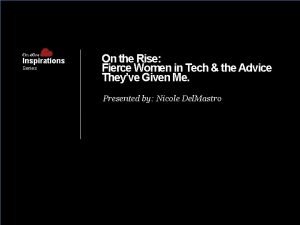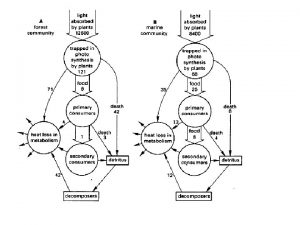Volvox THE FIERCE ROLLER Why do they interest














- Slides: 14

Volvox “THE FIERCE ROLLER”

Why do they interest us? • Individual cells that cooperate together in a colony to behave like a multicellular organism • Good for studying the origins of multicellularity because easy to find (pond scum!), division of labor, well-studied, relatively young (can study genomes relatively untouched by genetic drift), easily manipulated

How are they like multicellular organisms? • Individual cells are connected to each other through cytoplasmic bridges; formed from incomplete cytokinesis • Each cell uses its flagella in unison with the other cells to propel the entire colony • All cells don’t have the same job; division of labor (germ-soma)! • Can undergo both asexual and sexual reproduction

How does it move? • Each cell has two flagella, but they’re not the same; one is older than the other, and they move like in breast stroke • Ca+2 concentrations control which flagella dominates, allows the colony to turn, important for finding light or avoiding too much light • Flagella stick out of the colony and propel

How does it reproduce? • Asexually: not binary fission, but multiple fission. Grows to 2^n times its own size and divides n times. Have bigger cells from asymmetric division, gonidia, do the dividing; division of labor • Sexually: males secrete pheromone that cause other males to reproduce sexually. Used when conditions unfavorable to produce spores capable of withstanding harsh conditions; sperm (divides) and egg (grows) • Look!

What can they tell us? • Many different species of Volvox; all evolved separately, relatively recently, can study to figure out how multicellularity arises (see handout for controversy) and the different routes the Volvox took (same genes for reproductive repression? Same molecular pathways to same morphological end? Modified old genes or new genes? )

Sources • http: //micro. magnet. fsu. edu/moviegallery/pondsc um/protozoa/volvox/index. html • http: //www. btinternet. com/~stephen. durr/volvox. html • http: //protist. i. hosei. ac. jp/PDB/Images/Chlorophy ta/Volvox/ • http: //www. microscopyuk. org. uk/mag/indexmag. html? http: //www. micros copy-uk. org. uk/mag/artdec 03/volvox. html • Kirk, David L. Volvox: Molecular-Genetic Origins of Multicellularity and Cellular Differentiation







 Hey bye bye
Hey bye bye Nominal v. real interest rates
Nominal v. real interest rates Effective interest rate formula
Effective interest rate formula Compound interest meaning
Compound interest meaning Sadness simile
Sadness simile Fierce conversations 7 principles
Fierce conversations 7 principles Fierce conversations 7 principles
Fierce conversations 7 principles Scarlet majors
Scarlet majors Base details siegfried sassoon
Base details siegfried sassoon Comparative long
Comparative long Fierce conversations template
Fierce conversations template Its platinum loops shrink to a wedding-ring
Its platinum loops shrink to a wedding-ring Amanda leet
Amanda leet If i were fierce and bald and short of breath
If i were fierce and bald and short of breath Dont ask
Dont ask



























